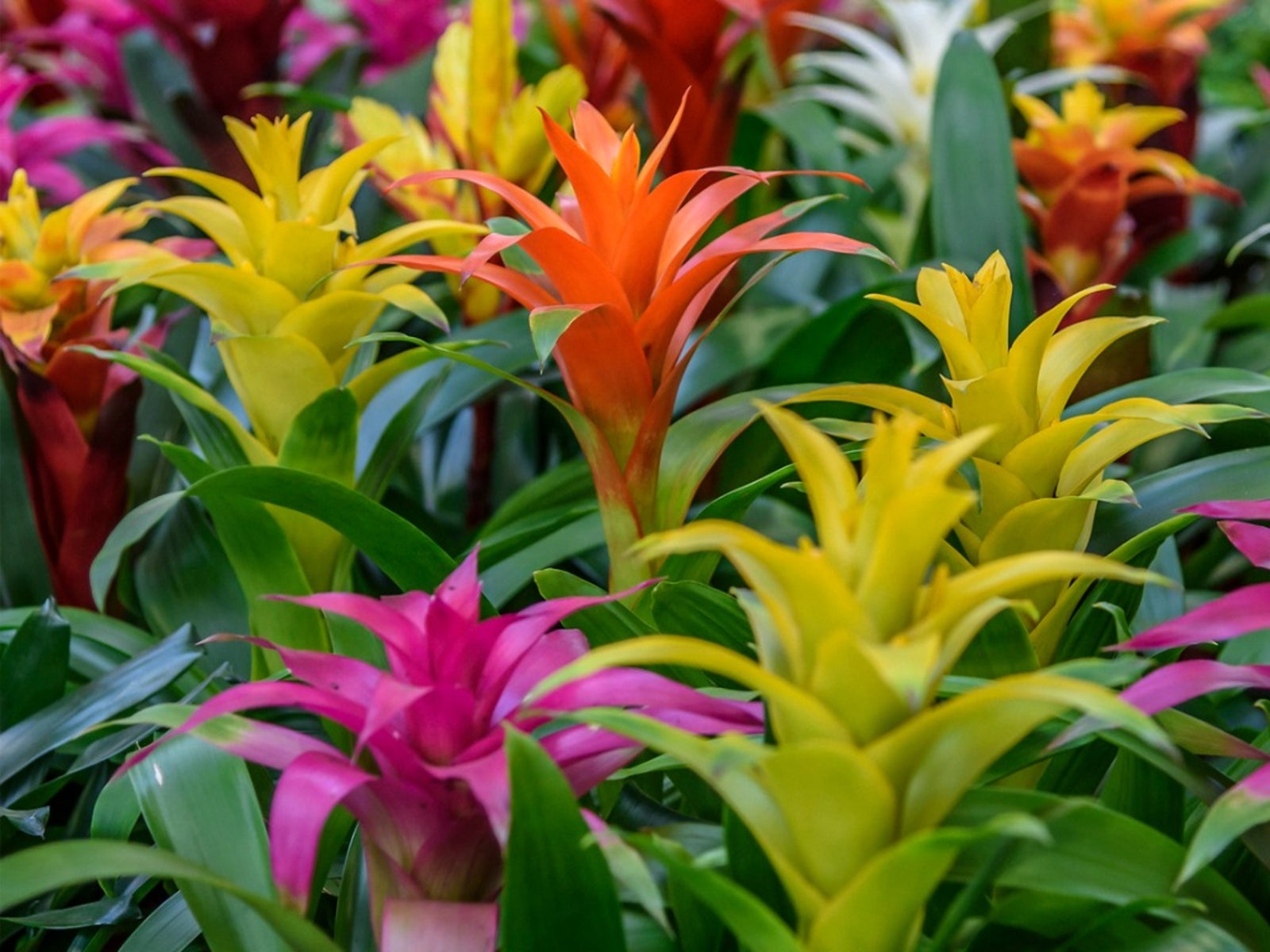How To Grow Guzmania – Caring For Beautiful Blooming Bromeliads
Gorgeous guzmania plants are colorful and dramatic and can light up a room, but it’s good to get familiar with what they need to thrive.


Guzmania Houseplant Care And Growing Guide
There are about 120 species of Guzmania bromeliads. Guzmania grows in a rosette form with pointed leaves and a cup-like center where the plants collect water. The plants produce astounding deeply colored blooms and the leaves can also be quite colorful. Bromeliads are fairly common houseplants, although they are epiphytic, which means they grow in trees and rock crevasses in their native range. There are a few secrets to Guzmania care, but mostly this is a fuss-free houseplant.
Quick Facts
- Botanical name:
- Guzmania lingulata
- Height: 3 feet (.91 m.)
- Spread: 2 feet (.61 m.)
- Sun exposure: Filtered light
- Soil requirements: Well draining
- Hardiness zones: USDA 11
- When to plant: Outdoors in spring
Guzmania Care
Most bromeliads are sold when they are in bloom, and the flower is something you can’t pass up. Technically, what we think is the flower is actually colorful bracts or modified leaves. The true bromeliad flowers are generally white, small, and unremarkable, but flanked by the colorful bracts. The flower lasts for months but when it dies, the parent plant will die. However, the bromeliads produce pups, which makes the plant evergreen.
Light
Most of the Guzmania plant species are native to Florida and tropical America. Depending on the species, the plant may prefer full sun to partial shade. Filtered, indirect light in the home is preferable to most of these species. The bromeliad Guzmania plant is often found in the understory of a tropical forest, where it forms in tree crotches. The trees create a naturally dappled light that most Guzmania species prefer.
Water
While you can water the plant at the soil level, most bromeliads may be watered by pouring the liquid into the “cup” or “tank” formed by the rosette. Periodically, flush the cup until old water pours out. The soil may be left fairly dry as long as the cup has water. In the winter, the cup can be allowed to dry out for longer periods. Bromeliads can be sensitive to some municipal water sources. Use distilled or demineralized water for best results, or let your tap water off-gas on the counter for a day before adding it to the plant.
Temperature & Humidity
Sign up for the Gardening Know How newsletter today and receive a free copy of our e-book "How to Grow Delicious Tomatoes".
These are tropical plants and have no cold tolerance. Optimal temperatures are between 60-85 degrees Fahrenheit (15.56-30 C.). They are hardy to United States Department of Agriculture zones 9-12 and can be brought outside in a partially shaded location in summer. Mist the plant in the summer to add humidity to the air. The plant’s container could also be placed on a saucer filled with pebbles and water. As the water evaporates, it will moisten the air around the plant.
Soil
The bromeliad Guzmania needs well-draining soil. An orchid soil with bark will do nicely. The key is to have a nice porous medium which will drain well and allow oxygen to the roots. Make up your own mixture with 1 part peat moss, 1 part bark, and 1 part vermiculite. Some species, especially the smaller ones, can be grown without soil, bound to a piece of wood with sphagnum moss which is kept misted.
Fertilizer
Feed the plant a couple times during the year with a diluted by half with houseplant or bromeliad food. You can spray the leaves with this mixture, as well. Do not fertilize in summer when the plant is dormant and not actively growing.
Problems, Pests & Diseases
The most common problem when caring for Guzmania is overwatering the soil. The roots of this plant will rot if the soil is kept moist. Allow the soil to dry out before adding moisture. Occasionally leaf spots will show up on leaves that get too much moisture on the surface. Avoid watering the leaves when filling the tank. Plants grown outside in summer may be plagued by mealybugs, scale, and aphids.
Pruning
When the main plant dies after the flower is gone, use a sharp, clean tool to gently prize it away from the pups. You can remove damaged or dead leaves at any time of the year by pulling them or cutting them away from the main body.
Propagation
Guzmania lingulata and its cousins will form offsets or pups. These are initially smaller rosettes that develop at the side of the parent plant. You may want to divide these and pot them up separately.
Repotting
If the soil becomes compacted, replace the soil with fresh medium. Guzmania bromeliads don’t mind being pot-bound and do not need a larger container very often. Be careful of the tender roots when you remove the plant from the old soil and gently pack the new medium around them.
Overwintering
These are not cold hardy plants and should be brought indoors for winter. As soon as nighttime temperatures drop below 60 degrees Fahrenheit (15.56 C.) take them inside until spring temperatures warm.
Varieties
With 120 varieties it’s hard to list them all. Some of the more common are:
G. lingulata
G. monostachia
G. conifera
Frequently Asked Questions
- How Long Do Guzmania Flowers Last?The flowers of these amazing plants can last 2 or even 5 years depending upon their culture and variety.
- Is a Guzmania Plant Happier Indoors or Outdoors?Depending where you live the plants may grow in either location. But they are not frost-hardy; they need plenty of humidity, and shelter from the sun. In Florida, where they are native, they can be grown outside all year round. In a cold climate, they are best grown indoors.